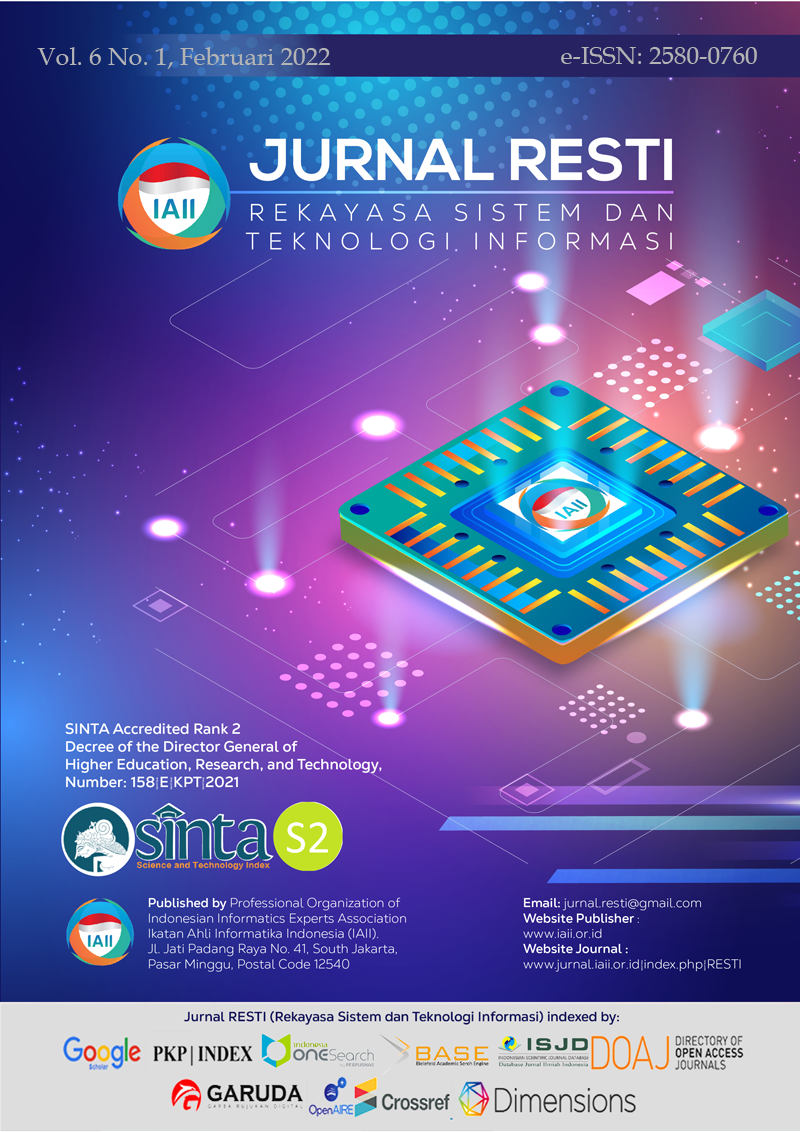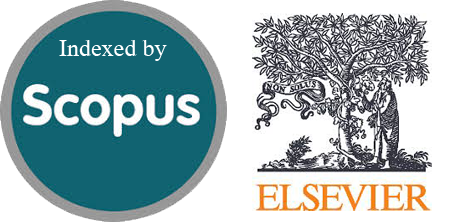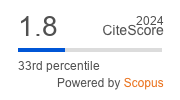Identifikasi Citra Pap Smear RepoMedUNM dengan Menggunakan K-Means Clustering dan GLCM
Identification of The RepoMedUNM Pap Smear Images using K-Means Clustering and GLCM
Abstract
Cervical cancer’s a gynecological malignancy in women that’s very dangerous, even causes death. Prevention through early detection of Pap smear test. It was carried out by pathologists with the help of a microscope still have obstacles in observations. There’re many studies on Pap smear image processing for helping pathologists in cell identification. Availability of Pap smear image dataset is needed in cervical cancer early detection research. The purpose of this study was to segment, feature extraction and classify 180 Pap smear images of RepoMedUNM. The method used to identify Pap smear images begins with preprocessing, namely changing the color in the image to L*a*b color, segmentation using the K-means method, extraction of 6 features, namely metric, eccentricity, contrast, correlation, energy, and homogeneity, and then identified by calculating the closest distance between the training data features and the test data features with the Euclidean distance. The result of identification ThinPrep Pap smear images in 3 classes achieve average accuracy of 93.33%, Non-ThinPrep Pap smear images in 2 classes achieve 90% average accuracy and the average accuracy of the overall in the 4 classes reached 92%. These results indicate that the proposed method can identify Pap smear images well.
Downloads
References
A. N. Dzulfaroh, “Sensus Penduduk 2020: Jumlah Laki-Laki di Indonesia Lebih Banyak dari Perempuan,” Kompas.com, 2021. [Online]. Available: https://www.kompas.com/tren/read/2021/01/22/113600465/sensus-penduduk-2020--jumlah-laki-laki-lebih-banyak-daripada-perempuan?page=all.
O. Primadi, Health Statistics (Health Information System), Katalog da. Jakarta: Kementrian Kesehatan RI, 2019.
J. H. Algadri, “Studi Deskriptif : Tindakan Pencegahan Kanker Serviks Pada Wanita Usia Subur di Wilayah Kerja Puskesmas Bakunase Kelurahan Fontein Kecamatan Kota Raja Kota Kupang,” Compos. Part A Appl. Sci. Manuf., vol. 68, no. 1, pp. 1–12, 2020.
S. Haryani, D. Defrin, and Y. Yenita, “Prevalensi Kanker Serviks Berdasarkan Paritas di RSUP. Dr. M. Djamil Padang Periode Januari 2011- Desember 2012,” J. Kesehat. Andalas, vol. 5, no. 3, pp. 647–652, 2016.
S. Syaiful, F. L. Tarigan, and F. Zuska, “Skrining Kanker Serviks Dengan Pemeriksaan Pap Smear Pada Profesi Bidan Di Rumah Sakit Tk Ii Putri Hijau Medan Tahun 2017,” J. Ris. Hesti Medan Akper Kesdam I/BB Medan, vol. 3, no. 2, p. 1, 2018.
N. A. Wantini and N. Indrayani, “Deteksi Dini Kanker Serviks dengan Inspeksi Visual Asam Asetat (IVA),” J. Ners dan Kebidanan (Journal Ners Midwifery), vol. 6, no. 1, pp. 027–034, 2019.
A. N. Sholihah and E. Sulistyorini, “Hubungan Antara Sikap Pencegahan Kanker Serviks Dengan Minar Deteksi Dini Menggunakan Inspeksi Visual Asam Asetat Pada Wanita Usia Subur di RW IV Desa Cangkol Mojolaban Sukoharjo Tahun 2015,” J. Kebinanan Indones., vol. 6, no. 2, pp. 102–116, 2018.
S. Anggraeni, “Self Efficacy Wanita Usia Subur untuk Melakukan Pap Smear Ditinjau dari Pengetahuan dan Dukungan Suami,” Viva Med., vol. 10, no. 18, pp. 86–93, 2017.
R. Kurniawan, D. H. Fudholi, I. Muhimmah, A. Kurniawardhani, and Indrayanti, “Feature Analysis of Normal Epithelial Cervical Cell Characteristics in Pap Smear Images,” 2018 2nd Int. Conf. Informatics Comput. Sci. ICICoS 2018, pp. 136–140, 2018.
J. Jantzen, J. Norup, G. Dounias, and B. Bjerregaard, “Pap-smear Benchmark Data For Pattern Classification,” Proc. NiSIS 2005, Albufeira, Port., no. January 2006, pp. 1–9, 2005.
M. E. Plissiti et al., “Sipakmed : A New Dataset For Feature And Image Based Classification Of Normal And Pathological Cervical Cells In Pap Smear Images Dept . of Computer Science & Engineering , University of Ioannina , Greece Dept . of Anatomy-Histology and Embryology , Facul,” 2018 25th IEEE Int. Conf. Image Process., pp. 3144–3148, 2018.
D. Riana et al., “Repository Medical Imaging Citra Pap Smear,” http://repomed.nusamandiri.ac.id/, 2021. [Online]. Available: http://repomed.nusamandiri.ac.id/.
D. Riana, S. Hadianti, and I. N. Karimah, “RepoMedUNM : A New Dataset for Feature Extraction and Training of Deep Learning Network for Classification of Pap Smear Images,” Int. Conf. Neural Inf. Process., vol. 1516, pp. 1–8, 2021.
T. Arifin, “Implementasi Algoritma PSO Dan Teknik Bagging Untuk Klasifikasi Sel Pap Smear,” J. Inform., vol. 4, no. 2, pp. 155–162, 2017.
R. S. D. Wijaya, Adiwijaya, Andriyan B Suksmono, and Tati LR Mengko, “Segmentasi Citra Kanker Serviks Menggunakan Markov Random Field dan Algoritma K-Means,” J. RESTI (Rekayasa Sist. dan Teknol. Informasi), vol. 5, no. 1, pp. 139–147, 2021.
T. Arifin, “Optimasi Decision Tree menggunakan Particle Swarm Optimization untuk klasifikasi sel Pap Smear,” JATISI (Jurnal Tek. Inform. dan Sist. Informasi), vol. 7, no. 3, pp. 572–579, 2020.
D. Riana, H. Tohir, and A. N. Hidayanto, “Segmentation of overlapping areas on pap smear images with color features using K-means and otsu methods,” Proc. 3rd Int. Conf. Informatics Comput. ICIC 2018, pp. 1–5, 2018.
N. Putu, A. Oka, I. K. Gede, D. Putra, and K. S. Wibawa, “Klasifikasi Sel Nukleus Pap Smear Menggunakan Metode Backpropagation Neural Network,” J. Ilm. Merpat, vol. 7, no. 3, pp. 224–232, 2019.
S. Rahayu, D. Riana, and Anton, “Segmentasi K-Means Dan Klasifikasi Cacat Pada Kayu Swietenia Mahagoni,” J. TECHNO Nusa Mandiri, 2021.
D. Riana, S. Rahayu, M. Hasan, and Anton, “Comparison of segmentation and identification of swietenia mahagoni wood defects with augmentation images,” Heliyon, vol. 7, no. 6, p. e07417, 2021.
G. P and V.Rajini, “YIQ Color Space based Satellite Image Segmentation using Modified FCM Clustering and Histogram Equalization,” Int. Conf. Adv. Electr. Eng., 2014.
V. K. Mishra, S. Kumar, and N. Shukla, “Image Acquisition and Techniques to Perform Image Acquisition,” SAMRIDDHI A J. Phys. Sci. Eng. Technol., vol. 9, no. 01, pp. 21–24, 2017.
S. Hadianti and D. Riana, “Segmentation and analysis of Pap smear microscopic images using the K-means and J48 algorithms,” J. Teknol. dan Sist. Komput., vol. 9, no. 2, pp. 113–119, 2021.
R. Rulaningtyas, A. B. Suksmono, T. Mengko, and P. Saptawati, “Multi Patch Approach in K-Means Clustering Method for Color Image Segmentation in Pulmonary Tuberculosis Identification,” Int. Conf. Instrumentation, Commun. Inf. Technol. Biomed. Eng., pp. 75–78, 2015.
K. Xiao et al., “Characterising the variations in ethnic skin colours: a new calibrated data base for human skin,” Ski. Res. Technol., vol. 23, no. 1, pp. 21–29, 2017.
S. Hartanto, A. Sugiharto, and S. N. Endah, “Optical Character Recognition Menggunakan Algoritma Template Matching Correlation,” J. Informatics Technol., vol. 1, no. 1, pp. 11–20, 2012.
N. Dhanachandra, K. Manglem, and Y. J. Chanu, “Image Segmentation using K -means Clustering Algorithm and Subtractive Clustering Algorithm,” Procedia - Procedia Comput. Sci., vol. 54, pp. 764–771, 2015.
N. Merlina, E. Noersasongko, P. Nurtantio, M. A. Soeleman, D. Riana, and S. Hadianti, Detecting the Width of Pap Smear Cytoplasm Image Based on GLCM Feature. 2020.
F. U. Karimah, Ernawati, and D. Andreswari, “Rancang Bangun Aplikasi Pencarian Citra Batik Besurek Berbasis Tekstur Dengan Metode Gray Level Co- Occurrence Matrix Dan Euclidean DistanCE,” J. Teknol. Inf., vol. 11, no. April, pp. 64–77, 2015.
N. H. Barnouti and W. E. Matti, “Face Detection and Recognition Using Viola-Jones with PCA-LDA and Square Euclidean Distance,” Int. J. Adv. Comput. Sci. Appl., vol. 7, no. 5, pp. 371–377, 2016.
K. Raval, R. Shukla, and A. K. Shah, “Color Image Segmentation using FCM Clustering Technique in RGB , L * a * b , HSV , YIQ Color spaces,” Eur. J. Adv. Eng. Technol., vol. 4, no. 3, pp. 194–200, 2017.
I. Ihsan, E. W. Hidayat, and A. Rahmatulloh, “Identification of Bacterial Leaf Blight and Brown Spot Disease In Rice Plants With Image Processing Approach,” J. Ilm. Tek. Elektro Komput. dan Inform., vol. 5, no. 2, p. 59, 2020.
A. Bhardwaj and A. Tiwari, “Breast Cancer Diagnosis Using Genetically Optimized Neural Network Model,” Expert Syst. Appl., 2015.
A. Mardhotillah, A. Atfianto, and K. N. Rahmadhani, “Menghitung Jumlah Buah Cabe Berwarna Hijau Menggunakan Metode Transformasi Ruang Warna RGB,” e-Proceeding Eng., vol. 5, no. 2, pp. 3641–3648, 2018.
Copyright (c) 2022 Jurnal RESTI (Rekayasa Sistem dan Teknologi Informasi)

This work is licensed under a Creative Commons Attribution 4.0 International License.
Copyright in each article belongs to the author
- The author acknowledges that the RESTI Journal (System Engineering and Information Technology) is the first publisher to publish with a license Creative Commons Attribution 4.0 International License.
- Authors can enter writing separately, arrange the non-exclusive distribution of manuscripts that have been published in this journal into other versions (eg sent to the author's institutional repository, publication in a book, etc.), by acknowledging that the manuscript has been published for the first time in the RESTI (Rekayasa Sistem dan Teknologi Informasi) journal ;








